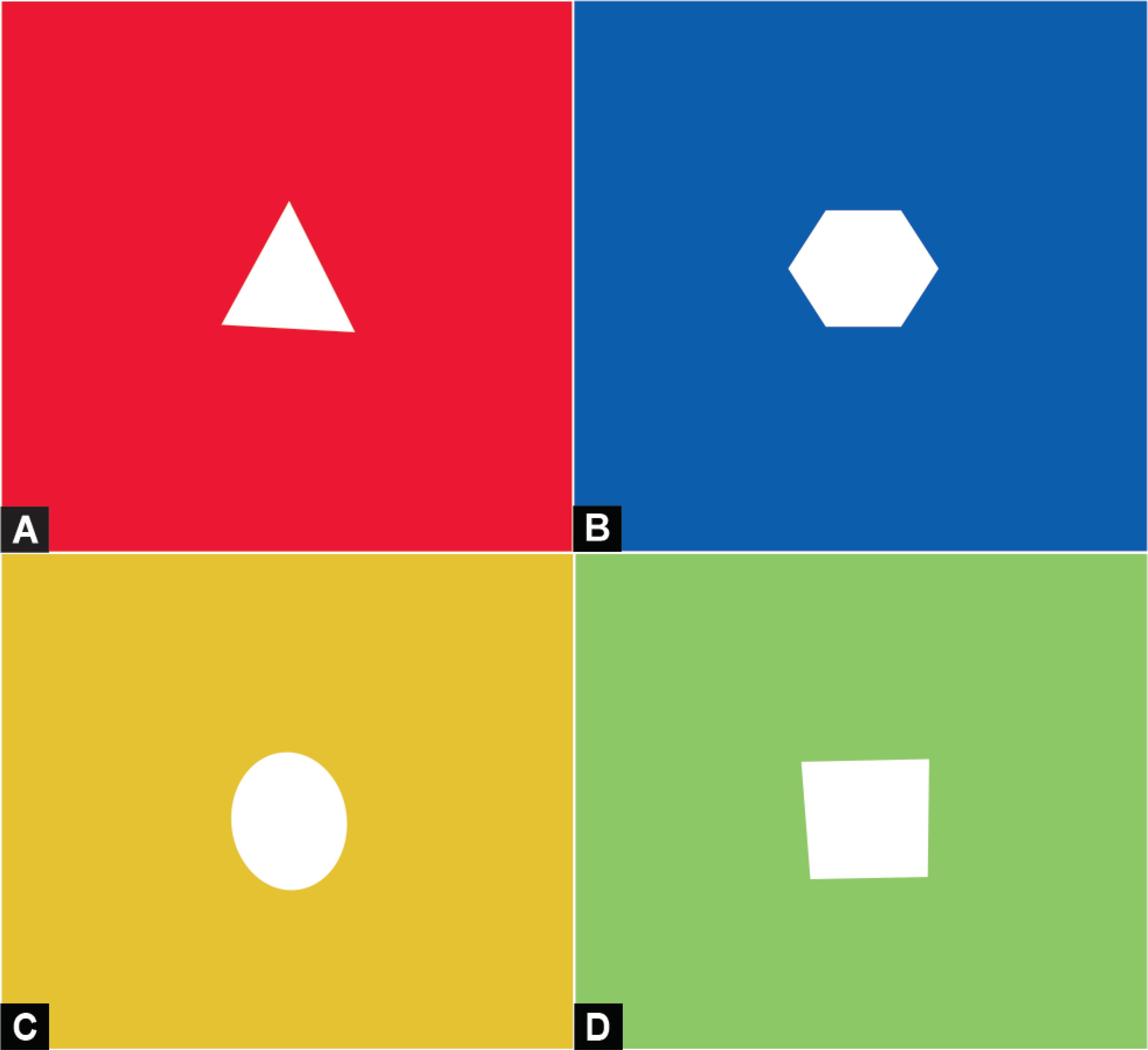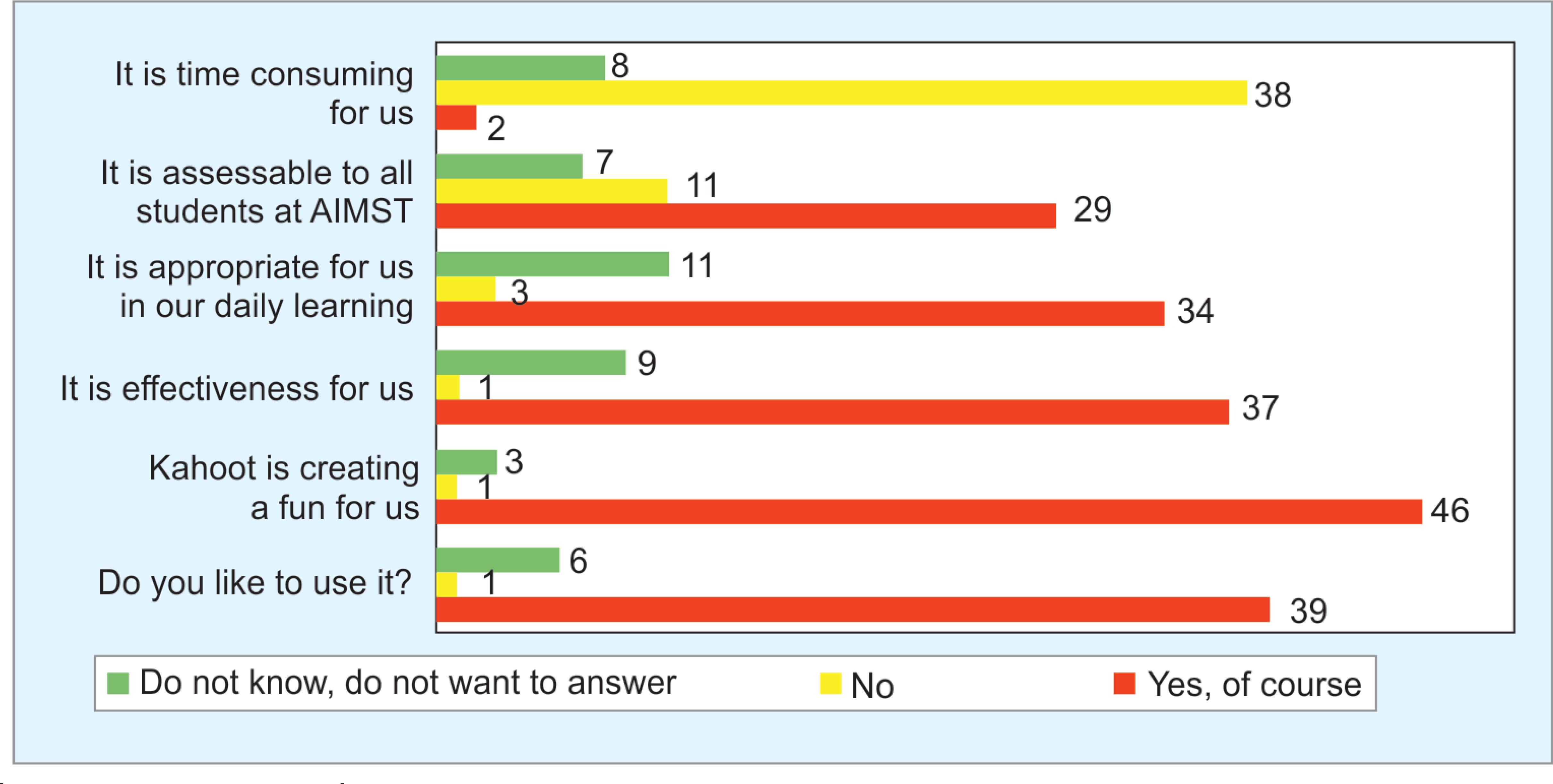SHORT COMMUNICATION | https://doi.org/10.5005/jp-journals-10082-02218 |
Students’ Perceptions on the Use of E-Quiz (Kahoot!(R)) to Enhance Learning Engagement
1Unit of Community Medicine, Faculty of Medicine, AIMST University, Bedong, Kedah, Malaysia
2Department of Medicine, Faculty of Medicine, AIMST University, Bedong, Kedah, Malaysia
Corresponding Author: Swe S Latt, Unit of Community Medicine, Faculty of Medicine, AIMST University, Bedong, Kedah, Malaysia, Phone: +60 109058032, e-mail: sweswelattdr@gmail.com
How to cite this article Latt SS, Sethuraman KR. Students’ Perceptions on the Use of E-Quiz (Kahoot!(R)) to Enhance Learning Engagement. J Basic Clin Appl Health Sci 2019;2(4):150–152.
Source of support:
Conflict of interest: None
ABSTRACT
An institution-based cross-sectional study on exploring the effectiveness of one of the electronic teaching–learning technologies (Kahoot! App) was undertaken. A 15-item e-quiz was conducted to a cohort of third-year MBBS students on the topic of Community Medicine previously taught to them. The students’ participation and feedback on the experience was quite positive. E-quiz using Kahoot! App seems to be an appropriate tool for formative assessment for the medical students and to improve their engagement in the classroom.
Keywords: Assessment for learning, Kahoot!, Quiz game, Student-engagement, Teaching–learning tool.
INTRODUCTION
Now a days, learning/teaching materials and tools are progressively going digital, and the present-day students, who are “digital natives,” prefer using information technology. We, the educators need to adapt to the learners’ interests and align our teaching–learning technologies to match their inclination. There are so many digital learning tools in use around the world; among them, Kahoot! is one of the popular tools available today for the educators to enhance their students’ learning experience.
ABOUT KAHOOT!
Kahoot! is a game-based learning platform launched in September 2017 that can be used as an educational tool in schools and higher educational institutions.1 The reasons to start “kahooting” are that it is flexible, simple, diverse, engaging, globally available, and free to use.2 It can be used for formative assessment and provides immediate feedback to the students. Kahoot! makes the teaching–learning process more efficient and productive and creates a joyous gamified milieu for today’s students; it is user-friendly, and the students can assess their own understanding of the taught subject matter in a timely manner.3
The appropriate times to use Kahoot! are during the post-lunch classes, to sum up new information, to gauge students’ understanding, and to break up a content-heavy lesson with self-review sessions.
The inappropriate times to use Kahoot! are at the start of the day, as a summative assessment tool, or to teach a new content. The limitations of using Kahoot! in class are availability of time, the difficult questions posed that could be disengaging, students’ anonymity, the need for devices as smart phones, tablet, and availability of access to the internet.4
Limitations for the instructor are that it need a projector, limited text length available for setting questions, and the results are not easy to analyze.
PRELIMINARY STUDY ON USAGE OF KAHOOT! AMONG YEAR 3 MEDICAL STUDENTS
Methodology
An institution-based cross-sectional study done on two small groups of year 3 batch 21, 50 medical students (2017–2018 academic session) during their community medicine posting with purposive sampling. The duration of the study was from June to July 2018. All the students had downloaded Kahoot! quiz game application for Android phone or for iPhone as needed.
Preparation for Kahoot! Quiz Game
The lecturer developed 15 questions on a topic to be taught and pretested by self. The steps to create the questions were as follows: access www.getkahoot.com; sign in—with email ID; set a password; ask to create a new quiz; enter a title name for the quiz; develop each the quiz item with four alternatives; choose the time allowed to answer each item, based on its complexity and difficulty level; click on the right answer; click to save this item; then move on stepwise, to add the items one by one until completing the set; and after saving the finalized quiz, change privacy to public, and then write the initial instruction for the students.
The second set of questions constituted a survey on the “student perceptions on the effectiveness of Kahoot! in their learning process” with 15 questions. The questions were as follows: “Have you ever heard about Kahoot!?, Have you been used Kahoot! before?, Which year did you start to use Kahoot!?, How many times have you used Kahoot! for learning Medicine?, What is your view on: the time spent on Kahoot!, effectiveness, appropriateness, accessibility, providing fun-learning, overall like or dislike this method, motivating your learning, improving your academic performance, how frequently do you want such quizzes during each posting, expectation on other lecturers to use similar quiz game.”
Running Kahoot! in the Classroom
After teaching the topic in community medicine, based on which, the quiz game had been designed, the lecturer introduced the quiz game and prepared the cohort to answer the quiz using Kahoot! App. The designated quiz appeared on the projector, and students inserted the code number on their phones. The names of those students, who successfully entered in the quiz game, were visible on the projector to all the students; their names could be “avatar names” or even anonymous or if they wished to do so. After verifying how many students had logged in to the quiz, the lecturer started to project the quiz items according to the preset timings. When the time for the item is over, the respondents would not be allowed to answer that item anymore. After clicking the answer box, each of the students got immediate feedback if his or her answer was right or wrong on his or her device; the first five students name were displayed after each question. Based on the percentage of correct answers by the students, the lecturer can proceed to the next item or discuss each item.
Pictures and videos could be embedded in quiz items that required the students to interpret, analyze, and answer the item. Kahoot! limits the text length of each quiz stem to 95 words or less and the length of each of the four alternatives to 60 words or less; the options are not numbered but identified by four different colored buttons; each student could click on any one button only (Fig. 1).
RESULTS
A total of 50 students of a private medical university in Malaysia participated in this study. Respondents’ perceptions on using the e-quiz on Kahoot! App were as follows: “not time consuming (n = 38); appropriate for their learning process (n = 34); effective (n = 37); creating fun-learning in a classroom (n = 46); like to use it more (n = 39).” Among them, 38 students strongly agreed on “Kahoot! motivates their learning process; may improve their academic performance (n = 31); 45 students agreed on encouraging their lecturers to use it” (Fig. 2 and Table 1).

Figs 1A to D: Four different shapes with different colors
DISCUSSION
“Assessment as learning” is a type that motivates the students’ learning process. It can be used to monitor the level of student achievement and performance in their medical education. One could use multiple assessment methods based on one’s focus: factual, contextual or performance assessment. MCQ items are one of the assessment methods to test application of knowledge: “knows” and “knows how” of the “Miller Pyramid.”5
In creating Kahoot! quiz game, one could use the multiple-choice format to select one best answer of the four options. One could also create true or false items but multiple true or false items are not allowed at present. Due to the word restrictions in the stem and the options, it was at times difficult to create scenario-based or problem-based questions. E-quiz is particularly useful as a revision tool for the topics taught on the previous day or week. It may be difficult to promote e-quiz in developing countries because of the lack of Wi-Fi “hot-spots” in the lecture halls; moreover, personal internet may be expensive making the students resist e-quiz.
RELATED ARTICLES
A recent study from Malaysia concluded “Kahoot! is a promising formative assessment tool that is feasible, fun, effective, motivates students to learn, but not the best option to simplify complex subjects.”6
A research-intensive teaching university in New Zealand explored students’ views about Kahoot! Their students reported that it “improved the classroom dynamics, engagement, motivation and learning process; minimized distracting classroom behaviors and activities, and improved the quality of teaching and learning beyond what could be provided in conventional classrooms.”7
Similarly, a master’s project from the US Military Academy has reported that “e-quiz based on Kahoot! seemed to narrow the performance gap between the lower and higher performing respondents and stimulated better performance.”8 A recent review article reported that “Kahoot! was useful in creating a fun and engaging environment and improved academic performance.”9
A study was conducted in 126 universities that used Kahoot! for an entire semester to assess if the students would get bored with using Kahoot! or not. The majority (57%) reported that they would like to continue using Kahoot! and 75% felt they had learned something from the e-quizzes.4
Even though e-quiz using Kahoot! was reported as an effective gamified learning tool by the students, there were some limitations for the instructors to make it a perfect assessment tool. The findings in this study is not generalizable in view of its limited coverage and representing only a cohort of medical students from a private university in Malaysia.
CONCLUSION
The benefits of using e-quiz such as Kahoot! in the classroom were quite apparent in this preliminary study. The students reported it as “fun and engaging.” It is a flexible tool to promote competitive spirit, motivate the students, activate the class, and useful to review facts and important points taught previously.

Fig. 2: Medical students’ perception on Kahoot! quiz game
| No. | Question | Strongly agree to agree | Neutral, no comment | Disagree |
|---|---|---|---|---|
| 1 | Kahoot! motivates students’ learning process. | 38 | 8 | 1 |
| 2 | Using Kahoot! in our learning may improve academic performance of the students. | 31 | 15 | 2 |
| No | Question | Yes, of course | No, I don’t want | No idea, no comment |
|---|---|---|---|---|
| 3 | I want my lecturers to use Kahoot! as one of the teaching strategies in our classroom. | 46 | 1 | 2 |
| 4 | Do you encourage your lectures to use Kahoot! after their lectures? | 45 | 2 | 2 |
ACKNOWLEDGMENTS
We acknowledge the cooperation and keenness of the third-year medical students for actively participating in this trial and trainee lecturers from medical universities of Myanmar.
REFERENCES
1. https://en.wikipedia.org/wiki/Kahoot!, accessed on 20 December 2018.
2. https://Kahoot.com/what-is-Kahoot/, accessed on 20 December 2018.
3. https://www.youtube.com/watch?v=8T2o3iwUYYA, accessed on 20 December 2018.
4. Virtual Classroom_Kahoot_Part2, https://www.youtube.com/watch?v=U9LlYaChfhU, accessed on 24 June 2019.
5. Miller GE. The assessment of clinical skills/competence/performance. Acad Med 1990;65 (9 Suppl):S63–S67. DOI: 10.1097/00001888-199009000-00045.
6. Ismail MA, Mohammad JA. Kahoot: a promising tool for formative assessment in medical education. Educ Med J 2017;9(2):19–26. DOI: 10.21315/eimj2017.9.2.2.
7. Licorish SA, George JL, Owen HE, Daniel B. Go Kahoot! enriching classroom engagement, motivation and learning experience with games. Proceedings of the 25th International Conference on Computers in Education 2017. pp. 755–764.
8. Borrell J, Cosmas N, Grymes J, Radunzel J, The effectiveness of Kahoot! as a pre-lesson assessment tool.(A Masters Project Report, available at https://linksolstaging.com/sites/default/files/inline-images/centers_research/center_for_teching_excellence/PDFs/mtp_project_papers/Borrell-Cosmas-Grymes-Radunzel_17.pdf, accessed on 30-10-2019).
9. Iwamoto DH, Hargis J, Taitano EJ, Vuong K. Analyzing the efficacy of the testing effect using Kahoot™ on student performance. Turkish Online J Distance Educ 2017;18(2):80–93.
________________________
© The Author(s). 2019 Open Access This article is distributed under the terms of the Creative Commons Attribution 4.0 International License (https://creativecommons.org/licenses/by-nc/4.0/), which permits unrestricted use, distribution, and non-commercial reproduction in any medium, provided you give appropriate credit to the original author(s) and the source, provide a link to the Creative Commons license, and indicate if changes were made. The Creative Commons Public Domain Dedication waiver (http://creativecommons.org/publicdomain/zero/1.0/) applies to the data made available in this article, unless otherwise stated.